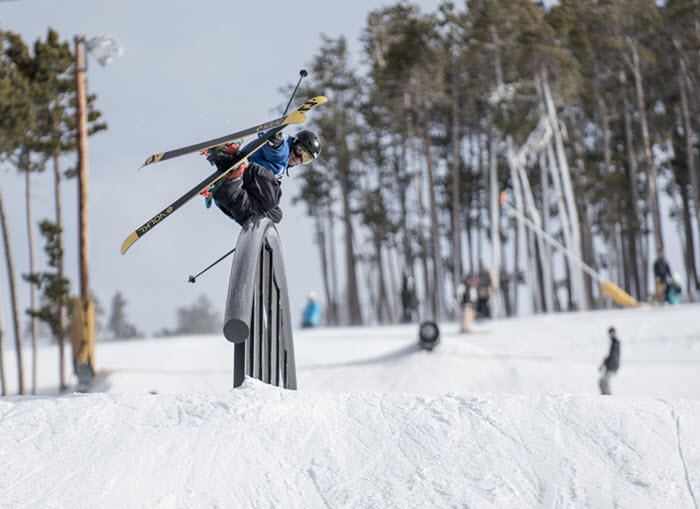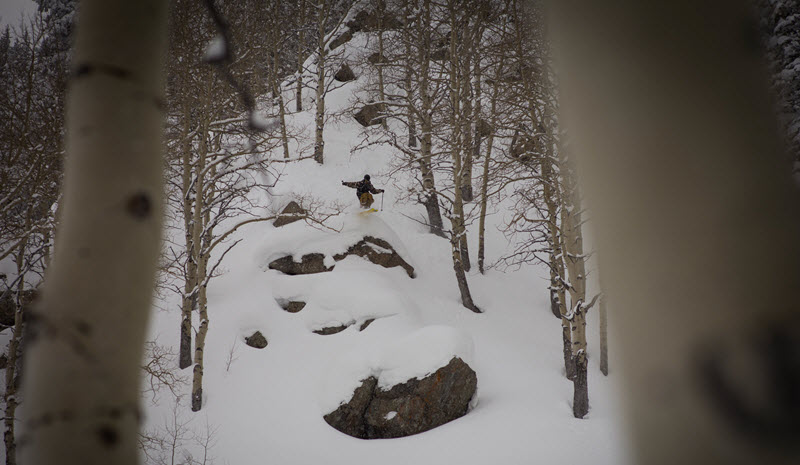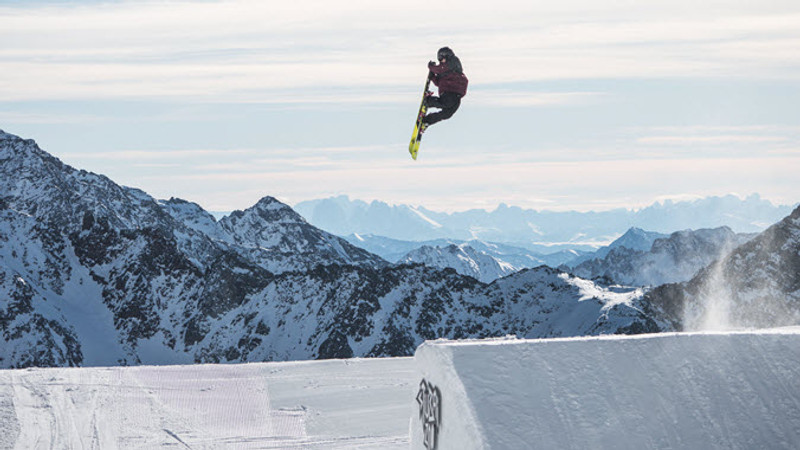Persevering with Slopestyle and Big Air.
There's an old adage in skiing that maintains, “If you're not falling, you're not trying.” But the best skiers know that it's not the falling that's important. It's getting back up. Again and again and again. And by that measure,
Kulkea athlete John Brown has proven that he belongs among the best in the world.
Brown is a dual threat in both slopestyle and big air competitions, events that feature high risk, high reward maneuvers. The rewards are podium finishes, and sponsorship dollars. The risks, though, are very real, and usually come in terms of bodily harm. Brown, a native of New England who competes as a of Ireland's national ski team, sustained a series of injuries over the past three years that would have deflated a lesser man.
Rolling into last winter, and the run-up to the Olympics, Brown was already behind the 8-ball. He had “torn up” a knee the previous season, and missed a number of qualifying events. As he clawed his way back into contention, Brown became a borderline candidate to make the Olympic cut.
As a member of
Team Ireland, Brown benefits from a “quota” system that limits the number of slopestyle competitors to four per country. That means Brown, Ireland's top slopestyle skier, can leap-frog higher ranked skiers from countries like the United States, Canada, Sweden, Switzerland, and Norway who won't make their national teams.
“It's the top 30 from around the world, capped four from each country,” he said. “The US team is so hard to get onto for the Olympics. There's about 10 or 11 people that are like me, but only four of the US skiers will be able to go. And there are so many more who could go, and do well.”
Still, at Mammoth, in the final qualifying meet before the Olympic Games in South Korea, Brown knew he had to go big. Instead, he wound up with the big hurt.
“During my first run, I came up short on the first jump and dislocated my SC joint, the collarbone at your sternum,” he said. “I tried taking a second run, not knowing what was up. My collarbone felt like it was broken. I was in a lot of pain. So I just straight-arrowed it, and that was it for me. I just didn't want to hurt myself again.”
With that injury, Brown's 2018 Olympic dreams evaporated. Missing out of the Olympics prompted Brown to reassess his life as a competitor, and he admits there were some dark moments.
“I definitely went through a phase there where I didn't really want to compete anymore, without seeing any major results,” said Brown. “Then you start skiing again, and all that goes away.”
This season, Brown has bounced back again, recommitting himself to his passion for the sport, and his passion for film making. He said he's looking forward to adding more chapters to a tale that is already quite remarkable for a young man who doesn't turn 24 until just before Christmas.
“Yeah, yeah, for sure,” he said, laughing. “I am stoked to ski.”

Dual Citizenship and Competition
Born in Gloucester, Massachusetts, Brown holds dual citizenship in Ireland and the United States, since his mother, Josephine, is a native of County Cork, Ireland. In fact, three of Brown's four grandparents are Irish. As a result of that lineage, Brown was eligible to ski for Team Ireland.
“There's no snow in Ireland, so it's like representing my roots with what I've become in the US, growing up around snow,” said Brown, who now makes his home in
Park City, Utah (opens in new window). “There's so many Irish people in the East Coast of America, around Boston. It's definitely an honor to represent my roots along with where I grew up.”
The South Korea Games were not Brown's first go round with the Olympics. He had initially attempted to make the 2014 Winter Games in Sochi, Russia, going as far to create a "Go Fund Me" campaign to finance the effort.
“I got a concussion that took me out of two of the qualifying events,” said Brown, though acknowledging that he probably wasn't ready for prime time. “Honestly, I had the tricks, but I didn't have the experience in the World Cup circuit.
“I just thought I could take these tricks I know and put them all together,” he said. “But when you drop next to your idol, you can get overwhelmed. And, you think 'Wow, I'm nowhere as good as this person. How am I going to land my run, and that can affect you.”
During his first World Cup meet, Brown found himself side-by-side with one of his idols, United State slopestyler Tom Wallace, one of his idols. The next time out, he dropped next to the USA's Bobby Brown, another childhood hero.
“So it was kind of crazy, and it took me a while to get comfortable on the circuit,” he said. “There are so many people – 80 people – at each contest. And it's hard to get it in your head that you can land a run and compete with these guys. You need the confidence to be able to perform.”
It was a quantum leap for Brown. Growing up, Brown and his family – parents Josephine and Paul, and sister Emily – spent time living in Massachusetts, Vermont, and Ireland, before settling in the ski village of North Conway, New Hampshire. There, Brown took advantage of the town's ski program for local youths at
Mount Cranmore (opens in new window). Like many children in the Mount Washington Valley, Brown became a ski racer at Cranmore, and also skied with the Eastern Slope Ski Club's Junior Program (opens in new window) out of North Conway's John Fuller Elementary School.
“I raced when I was younger, and I'm glad I did, because you got the fundamentals of skiing,” he said. “That was pretty good. I stayed on the ski team through high school, so I could get out of school one day a week. We got to leave halfway through our last block to go train, and then I'd hit the racecourse once and then go hit the park and ski.”
During that time, Brown realized that he was drawn more to grabbing air and doing tricks instead of the sheer top-to-bottom speed of alpine racing.
“On the weekends, I had a normal freeride team. We would jump on the side of the trails, and I liked that stuff,” he said. “So that took my attention away from the racing. Cranmore had a pretty good park back in the day, and I just gradually did more of that.”
Freedom of self-expression was a big attraction of the discipline, said Brown.
"What I like is flying through the air, for sure," Brown said. "You can do whatever you want. If you're doing something different than everyone else, it's better. It's more eye-catching. It's a way to show my personality through my skiing. It's how I like to go down the mountain, for sure.
“In racing, you've got to get through your gates, and you've got to be perfect, and you have to have the form of everyone else. And there's only one goal, to be the fastest,” he said. “With freestyle, you've got a course in front of you, and you've got to do your thing and throw your run together. It's almost like an art, so other people know what's going through your head. And you've got to back it up with the skills to do it.”
However, Brown recognized that his slopestyle performances had hit a plateau after his freshman year in high school. “We had a freestyle team development, but it wasn't the best,” he said. “And I was getting hurt, 'cause I wasn't getting the best coaching. That's when my parents said, 'Well, if you're going to do this dangerous stuff, you've got to go to someone who can help you do it safely.'”
Brown headed across the state via the famed Kancamagus Highway to
Waterville Valley (opens in new window)resort to join the Waterville Valley Black and Blue Trail Smashers, under the tutelage of coach Dan Shuffleton of Waterville Academy.
“There are really good kids there, kids I looked up to,” said Brown. “That's when I realized what could happen. You could see where the kids were going.”
Brown threw himself into every competition he could enter, from USSA Eastern Regionals to NOR-AM events to the Revolution Tour. Each was a chance to further hone his skills. He flirted with the idea of attending Plymouth State College after his graduation, but opted to heed the call of the West.
“I realized that some friends from Waterville were moving out West, and I thought, 'Well, I'm not going to get anything done without kids at my level to ski with,” he said. "I just totally sent it. I knew this was what I wanted to do, and staying on the East Coast wasn't going to help. Most of the contests are out West, and if they're not, they're in Europe. It's just better to be where the scene is.”
Brown became more confident in his abilities during three more World Cup campaigns, but has also developed a mental toughness forged during his recovery from reconstruction surgery to repair a torn ACL. Then, in his first contest back, during a World Cup meet in Switzerland, Brown caught a really bad wind gust during a training run “and went way too big. I actually fractured a vertebrae in my back. So (2016-17) was a total wash-out for competing, which was a bummer.”
But something else happened during Brown's recovery period – He fell in love with his sport all over again.
“It got me to sit back and enjoy skiing,” he said. “I mean really spending time just getting comfortable skiing again. For so long, I'd just get right into the contest scene, going contest to contest. And being scared about bad weather, these huge jumps, and you're got to do your gnarliest tricks.
“It was good to kick back. I wasn't 100 percent, but was just having fun skiing every day,” said Brown. “When you're competing every day, you're not really progressing. You're just trying to keep up.”

Looking Ahead
That's essentially the approach Brown is taking this season. The first two seasons following the Olympic Games actually give competitors a chance to recharge their batteries a bit.
This summer, Brown spent time at the Olympic training center in Park City, including jumping into a pool, and concentrated on getting his body right again. His first time skiing since his ill-fated run at Mammoth earlier this year, he pegged a Top 20 finish at the big air World Cup event in Italy in early November. The 2022 Olympics in Beijing, China, are a possibility, but right now they remain a distant ideal. Instead, Brown is intent on staying in the moment.
“The injuries didn't really get to me until I starting having back problems,” he said. “Once I started to hurt my back, I said, 'OK, I need to be smart.'
“So I started, this summer, to let myself heal up and rest, and then towards the end of summer, started working out harder than I have before,” Brown said. “I'm working with TB12, (New England Patriot quarterback) Tom Brady's company. We're doing a documentary with them. So I'm using their vibrating foam roller and their elastic bands to work out.”
Brown has also made significant changes to his diet, “drinking a lot more water to get my muscles to be looser, rather than tighter.” The idea is to treat his body right, in order to spend more time on the slopes.
“With the Olympics, you're training and all your efforts have to be into competing,” he said. “All the federations that fund you are saying 'We don't want you getting hurt if you go and film.'
“But that's what our sport was based on,” said Brown. “So it's kind of a bummer that the Olympics came in and that separated the sport into competing or filming. The Olympics are awesome, but they're definitely not all good.”
Brown's documentary work with TB12 is a natural extension of his ski film work, a passion that equals his competitive fire. He continues to collaborate with the film crew
4BI9 (pronounced 4-by-9) and you can check out his 2018 season edit on youtube (opens in new window). The current plan, Brown said, is to put together a film this winter during the time between his competition dates.
“My overall goals are to be consistent in competing, getting into finals on every World Cup I enter, put down runs and get my confidence rolling again,” he said. “And then obviously, I'm always trying to get a podium. But basically, it's really trying to stay healthy and consistent. And also producing a film segment that I'm proud of.”
Traditionally, competitive skiers have focused on making a name for themselves by concentrating on their events, letting their results draw sponsors and film crews. However, that dynamic is changing, said Brown.
“There's only a handful of people who put out a respectable segment with a full competition schedule,” said Brown with a chuckle. “That's the pinnacle of our sport – competing and filming.
“I've got a pretty good feeling that this winter, if I start filming, some other film companies will invite me to film with them,” he said. “I haven't really put as much effort into filming as I would like. Hopefully there will be a lot of filming in January. December will probably be soul shred, and having some fun.”
Recent Posts:
Buying Ski Gear Online Vs. Local Shops.
Caution is Not a Dirty Word.
A Tour of the Snowiest Places in America.

